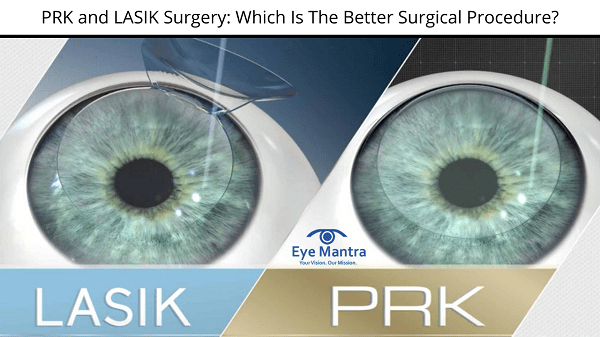PRK Laser surgery is also known as photorefractive keratectomy while LASIK is laser-assisted in situ keratomileuses. Both of them are different forms of laser surgeries that help the patient to improve their eyesight.
Both of these medical procedures are used to modify the cornea of the eye.
These two methods are different because they use different kinds of procedure to reshape your cornea.
Contents
WHAT CAN THESE TECHNIQUES RESOLVE?
PRK and LASIK surgeries can resolve the following eye related problems:
- Myopia: Myopia is the inability to see objects which are far away clearly.
- Hyperopia: hyperopia is the inability to see objects which are nearby clearly.
- Astigmatism: astigmatism is when the irregular shape of the cornea can cause blurry vision.
HOW CAN THESE SURGICAL PROCEDURES WORK?
Both PRK and Lasik reshape the cornea of the eye, using laser instead of a blade.
There is one major difference between these two procedures:
During a PRK surgery the top layer of the corneal tissue is removed entirely but during LASIK a flap is created to allow an opening to the tissue which is below. The flap is then closed after the procedure.
WHAT HAPPENS DURING THESE PROCEDURES?
LASIK is a type of surgery that involves the laser-based eye procedure to treat eye abnormality. LASIK can be performed in one or both eyes. Before the procedure, the patient gets eye drops to numb their eyes. The patient sits on the chair and a device is put on the eye of the person to keep his eyes open. You will be asked to look at a point when the microkeratome opens a flap in your cornea and the laser reaches your eye and reshapes it. The laser will reshape the cornea based on your prescription, thus making the light refract clearly on the retina. At the end of the procedure, the flap will be replaced over the eye. A special type of contact lens is then placed on the eye which acts as a bandage. You are advised to rest for a while after the procedure. There is an improvement in the visual acuity by the end of the day or the next day. You are recommended to take a few days off from your work if you handle heavy machinery. You get a 20/ 40 vision after this procedure.
PRK SURGERY
Photorefractive keratotomy (PRK): PRK surgery is commonly carried out in an outpatient surgery center. The course of action takes about 15 minutes, usually. The process is as follows:
- Your eye will be locally anesthetized using eye drops.
- An eyelid holder will be placed on your eye to prevent you from blinking.
- Then the outer layer of cells on your cornea, called the epithelium, will be removed. To do this, a special brush, blade, laser, or alcohol solution may be used.
- You will be asked to stare at a point of light so that the eyes do not move.
- Now, the laser is used to transfigure the cornea. The laser comes from a special instrument that has been programmed with measurements for your eye.
There are some cases where PRK cannot be used like:
WHICH SURGICAL PROCEDURE IS MORE EFFECTIVE?
Both the surgical procedures PRK and LASIK surgery are effective in their ways, in correcting the vision of one person. The only difference between the two surgeries is in the recovery time, in PRK surgery, the recovery time can take a couple of weeks and still cause irritation while you can have clear vision right after your LASIK surgery.
WHAT ARE THE RISK ASSOCIATED WITH BOTH OF THE SURGICAL PROCEDURES?
Both of the surgical procedures have some amount of risks.
LASIK is considered as the more risky one because there is one additional step in closing the flap of the cornea.
These risks include:
- Vision changes: PRK and LASIK surgery can cause glares from bright light, haloes around lights, and double vision. You can have night blindness. This is temporary but it might take a couple of weeks to go away. You should talk to your eye doctor if these disturbances do not go away.
- Dry eye: Surgical procedures like LASIK can cause dry eyes. It can make your eyes produce fewer tears. This can also be permanent.
- Astigmatism: Sometimes PRK and LASIK can cause astigmatism. The curvature of your eye changes if the corneal tissue is not removed evenly. Another surgery might be needed for this.
- Vision loss: A complication in any of the surgery can cause partial or total vision loss. It can also cause blurry or cloudy vision.
WHO SHOULD GO FOR LASIK AND PRK SURGERY?
This is the basic eligibility criteria for a medical eye surgery:
- You should be above 18 years of age.
- You vision can be improved to 20/40
- You vision should not change significantly within one year.
- You should not be pregnant or breastfeeding.
You are not eligible for the surgery if:
- You have chronic eye allergies which can affect eye healing.
- You have diabetes.
- You have glaucoma
- If you have had another eye surgery before.
At our eye care center, Eyemantra Care-you can have both PRK and Laser LASIK Surgery, Lasik Surgery in Delhi performed by experienced and well-trained ophthalmologists. They reduce the chances of any complications or risk and you can have a stress-free recovery from the surgery. Contact us on: Ph:+91-9711115191
